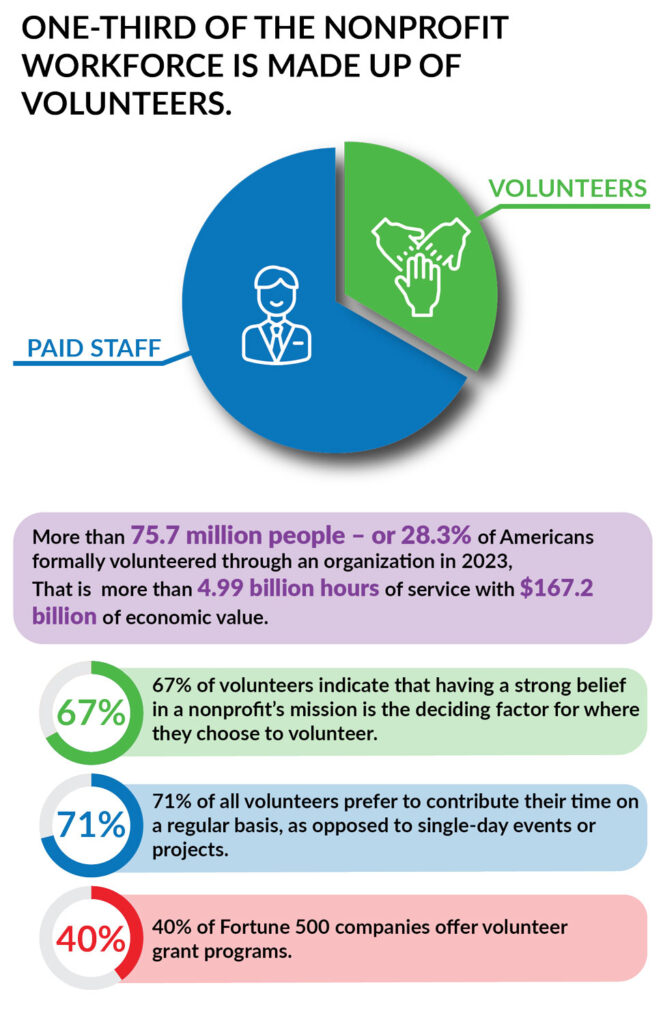In 2025, nonprofits can significantly improve volunteer engagement by focusing on flexibility, technology, and recognition. Here are some key strategies:
1.) Flexible Opportunities:
Offering flexible schedules and remote volunteering options can attract a diverse range of volunteers. This approach accommodates different lifestyles and commitments, making it easier for people to contribute their time and skills.
2.) Leveraging Technology:
Utilizing AI and other technologies can streamline volunteer management. AI can match volunteers with tasks that suit their skills and interests, enhancing their experience and satisfaction. Additionally, online platforms can facilitate better communication and coordination.
- Bloomerang Volunteer: Streamlines volunteer management with custom forms, automated data transfers, scheduling tools, and a two-way sync with Bloomerang’s donor CRM to cultivate donor-volunteer relationships.
- Get Connected by Galaxy Digital: Offers streamlined event management, team coordination, and volunteer profiles to enhance recruitment and engagement.
- Volunteer Local: Simplifies volunteer sign-ups with social sharing, custom registration forms, and sortable reports.
- 360MatchPro: Focuses on volunteer grant eligibility with searchable employer databases, embeddable tools, and detailed corporate program insights.
- SignUpGenius: Provides customizable sign-up pages, auto-generated notifications, and a Premium plan.
- Civic Champs: Offers mobile check-ins, group onboarding, and filtered reporting to enhance volunteer engagement and ROI.
- VolunteerMark: Features volunteer imports, skill-based assignments, and self-updating profiles with plans.
- Volgistics: Delivers customizable solutions with self-scheduling, background checks, and secure site-level access for volunteer data.
- Rosterfy: Includes gamified recognition, workflow automation, and skills-based training modules for streamlined volunteer management.
- Submittable: Empowers corporate volunteers with dashboards, automated communications, and tools for creating team volunteer opportunities.
- Mobilize: Enhances engagement with post-event feedback, grassroots opportunity management, and real-time reporting.
- BetterImpact: Optimizes volunteer management with advanced search, recurring scheduling, and robust data security features.
- SignUp.com: Simplifies volunteer sign-ups with mobile-friendly pages, waitlist notifications, and a free starter plan.
- Golden: Manages large volunteer groups with location-based apps, CRM integrations, and localized compliance tools.
- FestiVOL: Designed for event organizers with customizable applications, scheduling algorithms, and onsite management tools.
- POINT: Streamlines volunteer activities with website integration, shift management, and automated time tracking, starting with a free plan.
- Plan Hero: Simplifies scheduling with auto-reminders, color-coded roles, and personal calendar sync for volunteers.
- Helper Helper: Offers segmented opportunities, comprehensive reports, and personalized support for volunteer coordination.
3.) Personalized Communication:
Tailoring communication to individual volunteers can make them feel valued and appreciated. Regular updates on the impact of their contributions and personalized thank-you messages can strengthen their connection to the organization.
4.) Training and Development:
Providing training and development opportunities can help volunteers feel more competent and confident in their roles. This investment in their growth can lead to higher retention rates and more effective volunteer work.
5.) Recognition and Rewards:
Recognizing and rewarding volunteers for their efforts is crucial. This can be done through awards, public acknowledgments, or small tokens of appreciation. Celebrating their contributions fosters a sense of community and motivates continued involvement.
6.) Understanding Volunteer Demographics:
According to Double the Donation, most U.S.-based volunteers are between the ages of 35 and 44. Recognizing this demographic can help nonprofits tailor their recruitment and engagement strategies to better meet the needs and preferences of their volunteers.
7.) Corporate Volunteer Programs:
Many companies are increasingly encouraging their employees to volunteer, often offering volunteer grants and paid volunteer time off. Nonprofits can tap into these corporate programs to expand their volunteer base and benefit from additional resources.
8.) Highlighting Volunteer Benefits:
Regular volunteerism offers numerous benefits, including personal fulfillment, professional skill development, and even health benefits. Communicating these advantages can attract more volunteers and encourage long-term commitment.
By implementing these strategies, nonprofits can create a more engaging and supportive environment for their volunteers, ensuring a sustainable and impactful volunteer program in 2025.

Tania Quigley, CPA
Partner
Tania Quigley has been a member of Cerini & Associates’ audit and consulting practice area since 2005 where she focuses on serving the firms nonprofit and employee benefit plan clientele. Tania has experience in performing financial statement audits and reviews, tax return preparation, cost report preparation and filing, retirement plan audits, and other consulting. Tania brings her expertise, diversified background, and helpful approach to all of her engagements.





No comment yet, add your voice below!